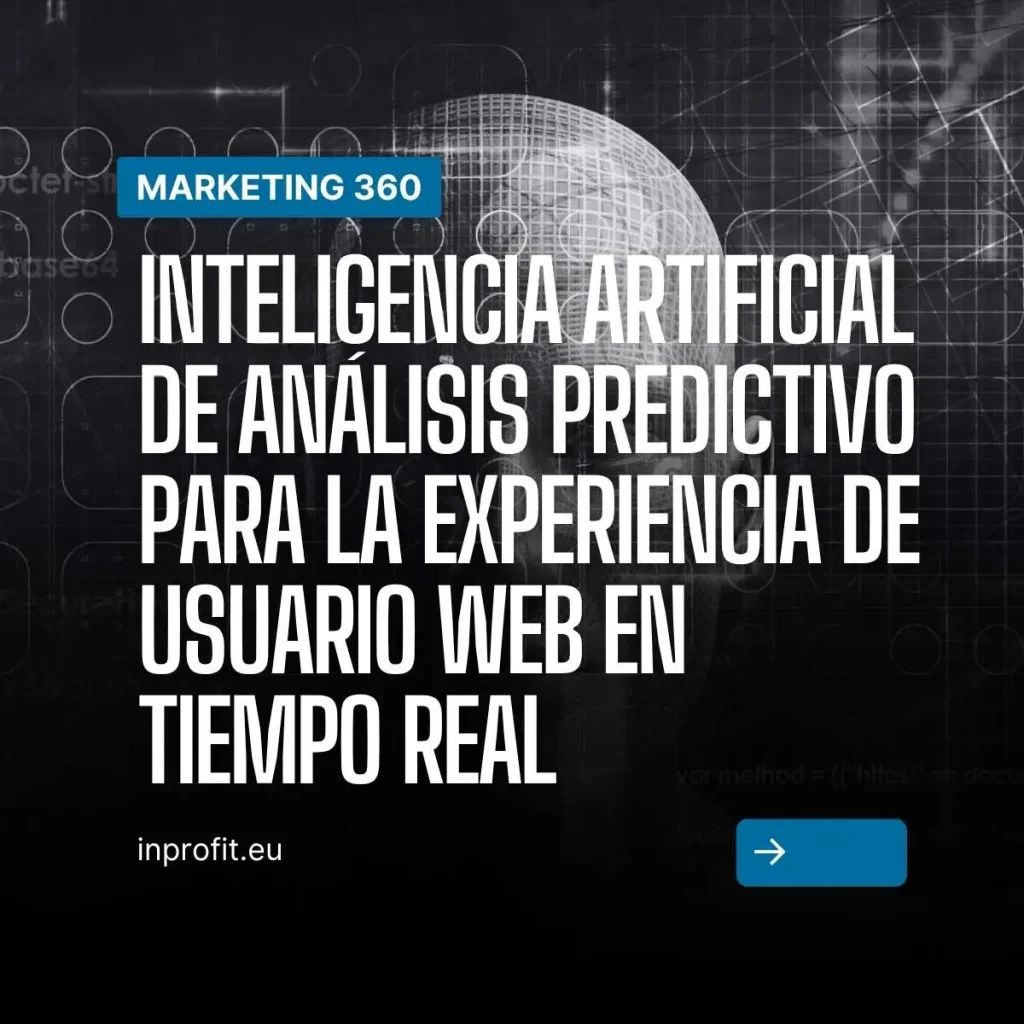By combining machine learning algorithms, real-time data processing and user behavior analysis, predictive AI solutions allow you to personalize experiences, anticipate needs and improve conversion rates.
In this article, aimed at specialized departments and companies, you will discover how predictive analytics AI can be applied to the real-time web user experience, with a technical focus on methodologies, tools and business value generation.
Predictive AI in the web user experience
Web user experience encompasses all aspects of a user’s interaction with a website, from navigation and design to personalization and loading speed. According to market research, a one-second delay in loading a page can reduce conversions by 7%, while 68% of users abandon a site if the experience is unsatisfactory. Predictive AI addresses these challenges by:
- Anticipate Behavior: Predict user actions (such as clicks or abandonments) based on historical patterns and real-time data.
- Personalize Experiences: Tailor content, recommendations and navigation flows according to individual preferences.
- Optimize Performance: Identify UX bottlenecks, such as slow loading times or unintuitive designs.
- Increase Conversions: Improve key metrics such as conversion rates, dwell time and user retention.
Predictive AI enables companies to move from a reactive to a proactive approach, delivering web experiences that dynamically adapt to user needs.
How to apply predictive behavioral analytics?
Real-time data collection
Predictive AI relies on high-quality data collected in real time, such as clicks, cursor movements, time on page and navigation paths. This data is obtained through tracking and analysis tools.
- Technical Application: Implement tracking pixels (such as Google Analytics or Hotjar) and behavioral SDKs to capture real-time events, ensuring compliance with privacy regulations such as GDPR or CCPA.
Machine Learning Models
Machine learning algorithms, such as decision trees, neural networks or clustering models, analyze data to predict behaviors and segment users.
- Technical Application: Train machine learning models in frameworks such as TensorFlow or Scikit-learn, using historical datasets to predict actions such as cart abandonment or conversion probability.
Dynamic customization
Predictive AI makes it possible to adapt content in real time based on user behavior. For example, an e-commerce site can display product recommendations based on previous user interactions.
- Technical Application: Implement recommendation engines based on collaborative or content-based filtering algorithms, integrated through APIs such as Algolia or Dynamic Yield.
Interface optimization
Predictive analytics identifies interface elements that negatively affect UX, such as inconspicuous buttons or complex forms, and proposes improvements in real time.
- Technical Application: Use heat mapping tools and session recordings (such as Hotjar or FullStory) combined with AI models to suggest design adjustments based on interaction patterns.
Real-time processing
The ability to process data and apply predictions in milliseconds is crucial for a smooth UX. This requires high-performance infrastructure and scalable systems.
- Technical Application: Deploy AI models on cloud computing platforms such as AWS Lambda or Google Cloud Functions to process data in real time with low latency.
Predictive AI application case studies for web UX
The application of predictive AI in web UX is driven by technological advances and rising user expectations. Key trends include:
Hypercontextual customization
AI makes it possible to personalize experiences not only based on demographics, but also based on real-time context, such as location, device or time of day.
- Strategic Application: Implement systems that combine geolocation data (through APIs such as Google Maps) with user behavior to display relevant content, such as local promotions.
Predictive dropout analysis
AI models can predict the likelihood of a user leaving a site, enabling real-time interventions such as discounts or personalized messages.
- Strategic Application: Configure workflows in platforms such as Mautic or Dynamic Yield to send push notifications or pop-ups when a model detects a high risk of abandonment.
Speed and performance optimization
La IA predictiva identifica cuellos de botella en el rendimiento del sitio, como scripts que ralentizan la carga, y sugiere optimizaciones automáticas.
- Strategic Application: Use tools such as Google Lighthouse combined with AI to prioritize critical resources (CSS, JavaScript) and improve load time.
Adaptive interfaces
Las interfaces web pueden adaptarse dinámicamente a las preferencias del usuario, como cambiar el diseño según el historial de navegación o las preferencias de accesibilidad.
- Strategic Application: Implement adaptive design frameworks such as React or Vue.js, integrated with AI models that adjust the interface in real time according to user behavior.
Integration with emerging technologies
Predictive AI is combined with technologies such as augmented reality (AR) or natural language processing (NLP) to create immersive experiences, such as intelligent chatbots or 3D product visualizations.
- Strategic Application: Develop NLP-based chatbots (using tools such as Dialogflow) that respond to real-time queries, integrated with predictive models to suggest personalized responses.
Business value generation
Predictive AI for web UX generates business value by improving key metrics, optimizing resources and strengthening the relationship with users. Here’s how this technology drives growth and competitiveness:
Increased conversion rates
Real-time personalization improves content relevance, increasing conversions. For example, AI-based product recommendations can increase sales by 10-15%.
- Case Study: An e-commerce store implemented an AI-based recommendation engine, increasing conversions by 12% by displaying relevant products in real time.
2. Reduction of abandonment
Predictive models identify users at risk of abandoning the site and trigger interventions, such as discounts or personalized messages, reducing the abandonment rate by an average of 20%.
- Case Study: A booking platform used AI to detect abandonment patterns on forms and displayed pop-ups with real-time assistance, reducing abandonment by 18%.
3. Improved customer experience
Personalization and interface optimization create seamless and relevant experiences, increasing user satisfaction and retention.
- Case Study: A financial services company integrated AI to personalize navigation according to user profile, improving customer satisfaction by 15% according to surveys.

4. Resource optimization
La IA predictiva reduce el desperdicio de recursos al priorizar mejoras en la UX que tienen el mayor impacto en las métricas de negocio.
- Case Study: A streaming platform used AI to identify scripts that were slowing down their site, optimizing code and reducing server costs by 10%.
5. Competitive differentiation
Companies that adopt predictive AI for UX position themselves as innovators, standing out from competitors with static or generic sites.
- Case Study: A fashion brand implemented an adaptive interface with AI that adjusted the design based on device and behavior, increasing dwell time by 20%.
6. Scalability for global markets
Predictive AI makes it possible to tailor experiences to different markets, such as personalizing content based on language, culture or local preferences.
- Caso Práctico: Una empresa tecnológica usó IA para personalizar su sitio en múltiples idiomas, aumentando las conversiones en mercados internacionales en un 14%.
7. Data-driven decision making
Predictive models provide actionable insights that enable companies to optimize strategies in real time, from design adjustments to marketing campaigns.
- Case Study: An online education platform integrated AI with Google Analytics to analyze navigation patterns, improving site structure and increasing enrollment by 10%.
Implementing predictive AI in enterprises
Collect behavioral data (clicks, scroll, time on page) and contextual data (location, device) using tools such as Google Tag Manager. Apply data cleaning techniques to remove noise and ensure accuracy.
Train machine learning models using historical and real-time datasets. For example, a logistic regression model can predict conversion probability, while a clustering model segments users by behavior.
- Tools: TensorFlow, PyTorch, Scikit-learn for modeling; AWS SageMaker for cloud deployment.
Website integration
Desplegar modelos predictivos mediante APIs que se integren con el frontend (React, Vue.js) o el backend (Node.js, Django) del sitio web, asegurando un procesamiento rápido y sin interrupciones.
- Ejemplo: Usar una API REST para conectar un modelo de recomendación con un sitio en WordPress, mostrando productos dinámicamente en WooCommerce.
Perform A/B testing to compare the performance of different customizations and optimizations proposed by the AI. Use metrics such as conversion rate, dwell time and bounce rate to evaluate the impact.
Implement dashboards (such as Tableau or Power BI) to monitor the performance of predictive models and detect deviations in real time, adjusting parameters as needed.
Conclusion
Predictive analytics artificial intelligence is revolutionizing the web user experience by enabling real-time personalization, interface optimization and behavior prediction.
By integrating machine learning models, real-time processing and data analytics, companies can improve conversion rates, reduce abandonment and deliver seamless experiences that build user loyalty. For specialized departments, the key is to implement these solutions with a data-driven approach, leveraging scalable tools and agile methodologies.
La IA predictiva no solo optimiza la UX web, sino que también impulsa el valor empresarial, posicionando a las marcas como líderes en un entorno digital competitivo.



